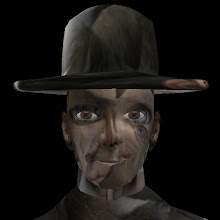Following on from my previous post, I have devised
The David Bowie MUVE Induction.
Stage 1.
(OpenSim standalone)
I am Ruth TestUser,
but that's not important right now, because nobody can see me. Oops. I can't walk properly.
Stage 2.
(OpenSim networked)
I am David Bowie,
but I look like Ruth. But look, so do my friends, Noddy Holder and Gary Glitter. Hahaha. Let's build a giant stage!
Stage 3.
(Second Life pre-paid names)
I am David Student,
Blue jean. A nice white t-shirt and blue jean.
Noddy Student, lets find a shop that sells spangly shoes! No Gary Student, you can't go to that sim, they'll be able to trace you.
Stage 4.
(Second Life full sign-up)
I am Ziggy Stardust,
and I'm going to find out what it feels like to be a GLAM ROCK GOD!
What's that you say Gary? Your own computer's graphics card is a bit slow when running Second Life? Why don't you take it into PC world?
Subscribe to:
Post Comments (Atom)
Idea Stains
-
▼
2008
(94)
-
▼
March
(10)
- Abductive reasoning part 2
- SLego
- Multiple personalities are a good thing.
- Massively Multiuser Learner Conference
- Some Ideas for Habitat island
- Stand alone in an open habitat.
- More pilot plan ideas.
- How to help absolute beginners who feel under pres...
- Identity and Ethics
- Wonderland/Darkstar vrs Second Life
-
▼
March
(10)

2 comments:
For those not familiar with U.K. pop culture, Gary Glitter was a 70s Glam Rocker who took his computer into PC World to get fixed, and then got arrested when they found dodgy images on it. Although I was primarily trying to be funny, there is a serious point about the potential ethical and PR risks involved in introducing students to a virtual world which offers vice and otherwise unsavoury content. If students know that they are traceable through their official Uni SL account, then they are bound by the University's regulations. What they do with their personal account is outside of Uni's remit, and they are then personally accountable. It's like what happens when students access the internet from inside Uni. JANET rules require students to log on before accessing the net through the Uni's network, so that they can be traced if they access dodgy content. What they do on their own PCs at home is up to them.
I really like the way you are linking together identity and orientation to the environment. This is a very friendly way of pointing out how complex the process os and that it's so much more than just a technical challenge.
Post a Comment